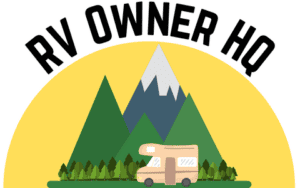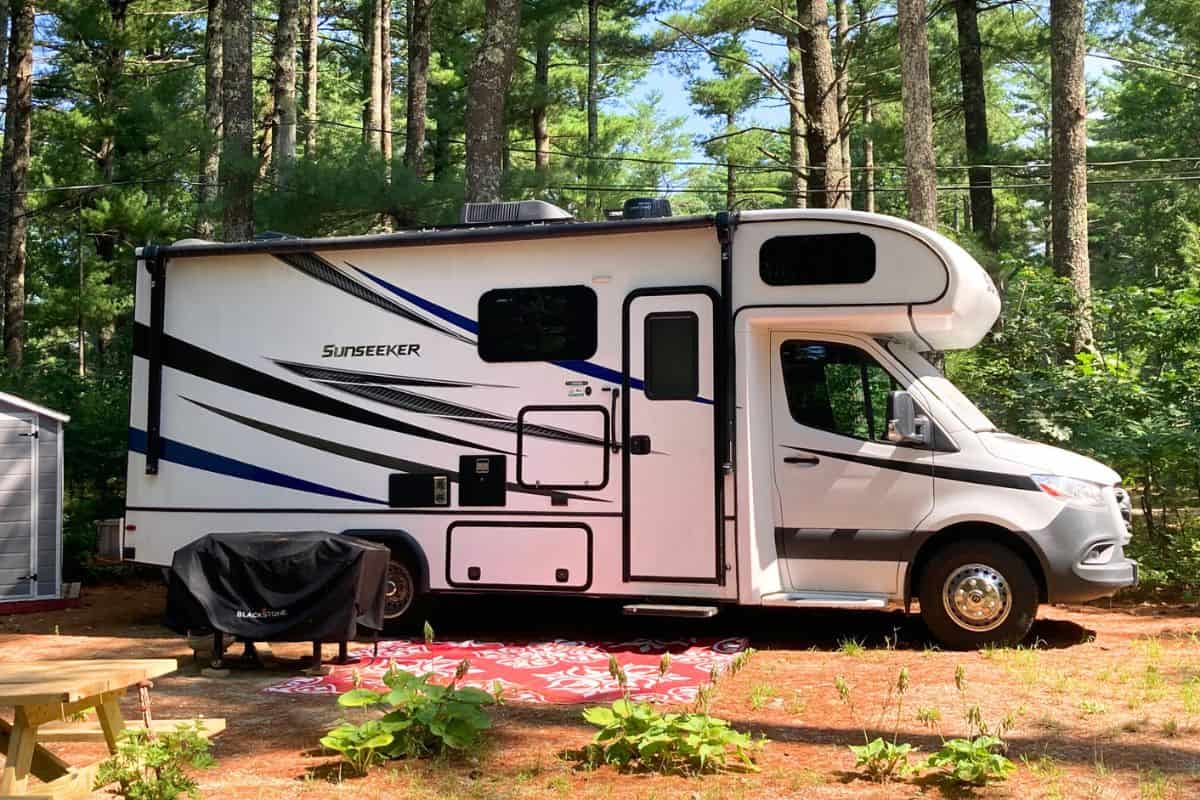Have you ever dreamed of waking up to a different view every morning?
Full-time RV living isn’t just a dream anymore, it’s becoming a reality for thousands of Americans seeking freedom, adventure, and a simpler life.
Whether you’re a soon-to-be retiree eager to explore National Parks, a digital nomad ready to work from anywhere, or a family looking to break free from the traditional lifestyle, transitioning to full-time RV living is a journey that begins long before you turn the key in the ignition.
So to help with this preparation let’s explore the 12 important steps to take before embarking on your full-time RV adventure.
Think of this as your roadmap to freedom that will help you avoid common pitfalls and set yourself up for success in your new nomadic lifestyle.
How to Prepare for Full-Time RV Living:
1. Research & Choose the Perfect Camper for Your RV Lifestyle
The foundation of successful full-time RV living starts with choosing the right home on wheels, as this one decision will significantly impact every aspect of your daily life on the road.
Let’s break down everything you need to know to make the best choice for you and your family.
Understanding the Different Types of RVs
- Travel Trailers: From tiny teardrops to 40-foot homes on wheels, travel trailers offer the most variety. They’re typically the most affordable RV type and the easiest to tow.
- 5th Wheels: Fifth wheels are generally the largest towable RV, ranging from 25 to 45 feet. Their raised forward section creates a bi-level living space with impressive ceiling height. However, you’ll need a heavy-duty truck to tow one.
- Class A Motorhomes: Class A motorhomes are luxurious buses that range from 30 to 45 feet and offer the most living space of any motorized RV. They’re perfect for those who want the comforts of home, with spacious living areas, full-size appliances, and plenty of storage. However, they can be challenging to maneuver and typically get 6 to 10 MPG.
- Class B Campervans: These converted vans are the smallest drivable RV, typically between 16 and 22 feet long. They’re incredibly easy to drive, can fit in regular parking spaces, and get the best fuel economy (15-18 MPG). Perfect for solo travelers or couples who prioritize mobility over space.
- Class C Motorhomes: Class C’s strike a balance between Class A and B, offering more space than a campervan but better maneuverability than a Class A. Known for their over-the-cab-bunk, they usually range from 23 to 33 feet, are great for families, and offer decent fuel economy (8-18 MPG).
- Truck Campers: Truck campers allow you to fit your entire home into the bed of a truck. Many include a kitchen, bathroom, and sleeping area while maintaining the truck’s maneuverability and off-road capability.
- Toy Haulers: Available in fifth-wheel and travel trailer configurations, toy haulers feature a garage area for motorcycles, ATVs, or other “toys.” They’re perfect if you want to bring adventure vehicles along but they do sacrifice living space.
Important Factors to Consider When Choosing an RV
- New vs. Used: For first-time full-time RVers, buying used typically makes the most financial sense since you’ll save 20 to 40% off new prices while benefiting from resolved maintenance issues, and reduced depreciation costs.
- Size & Maneuverability: Although larger RVs offer more living space, smaller campers under 30 feet allow access to more scenic campgrounds, better maneuverability, and reduced driving stress, especially for beginners.
- Storage Capacity: When choosing an RV for full-time living it’s important to prioritize storage like exterior compartments, under-bed space, ample wardrobes, and a large pantry.
- Four-Season Capability: Most standard RVs aren’t equipped for freezing temperatures and require winterization, which isn’t practical for full-time living. Basic RV insulation is sufficient if you plan to follow warm weather, but for cold-weather camping, you’ll need a four-season capable RV with features like a heated underbelly, tank heaters, double-pane windows, and extra insulation.
- Budget: The initial purchase price of an RV is just the beginning, as ongoing costs include insurance, annual maintenance (2-3% of purchase price or more for older rigs), and high fuel costs.
2. Master the Art of Downsizing

Transitioning to full-time RV living requires a major shift in how you think about possessions. The good news though is that while it seems overwhelming at first, it’s incredibly liberating once completed.
Start with an Initial Assessment
Starting your downsizing journey can feel like trying to eat an elephant. The secret though is to take it one bite at a time. Begin with a thorough room-by-room inventory of your current home. Walking through each space with a critical eye, you’ll need to make tough decisions about every item you own.
Consider sorting your belongings into these essential categories:
- Must-Keep Items (things you need for RV life)
- Maybe Items (set these aside for a second review)
- Sell/Donate Items (be ruthless here)
- Trash/Recycle (often the largest pile)
Practical Downsizing Strategies That Work
- The 90/90 Rule: The 90/90 Rule has been my go-to strategy for making tough decisions about what to keep. It’s super simple and requires just two basic questions. 1. Have I used this item in the past 90 days? 2. Will I use this item in the next 90 days?
- Best Place to Sell Stuff: Start your downsizing journey with a yard sale to quickly clear bulk items, then move on to selling valuable possessions through platforms like Facebook Marketplace, eBay, or specialty forums. For high-end items like designer clothing or furniture, consider consignment shops that handle the selling logistics for a percentage.
- Short-Term Storage Options: While climate-controlled storage units and family homes can provide temporary solutions for storing belongings during your transition to RV life, be cautious about letting these become permanent arrangements, as monthly costs add up and can defeat the purpose of simplified living. Keep external storage limited to truly irreplaceable possessions to avoid financial burden, dependency on fixed locations, and wearing out your welcome.
3. Set Up Your RV for Full-Time Living
When transforming your RV from a weekend camper into a full-time home there are many modifications you can do. These are some of the most popular full-time upgrades:
- Install a high-pressure showerhead
- Upgrade your RV mattress
- Install drawer organizers and hanging storage systems
- Add security features
- Install a residential-style kitchen faucet
- Add a cell phone signal booster
- Replace factory blinds with blackout shades
- Install a comfortable office/workspace setup
- Add solar panels and lithium batteries
- Install a tankless water heater
- Upgrade to a larger refrigerator
- Invest in a portable RV generator
- Add command hooks
- Install additional USB charging ports
- Replace stock lighting with LED fixtures
To see other Full-Time RV Tips, check out our blog post “100 Genius Travel Trailer Hacks to Simplify Your RV Life“.
Making your RV more livable is also really important and comes down to smart RV organization and comfort features.
Try maximizing your limited space by installing tension rods for vertical storage, using multi-functional furniture, and creating dedicated zones for work, relaxation, and dining.
When living full-time in an RV temperature control also becomes much more important. Some of the best ways to improve temperature regulation in a camper include adding reflective window coverings, using small fans for air circulation, and adding thermal curtains and window films.
4. Fully Understand & Have a Plan to Maintain All RV Systems
Understanding your RV’s core systems helps protect your investment and ensure comfortable living, while preventive maintenance saves money and headaches.
Your RV has four main systems that need regular attention:
- Electrical (12V and 120V systems, batteries, inverters)
- Plumbing (fresh, grey, and black water tanks, pipes, filters)
- Propane (lines, tanks, appliances)
- Mechanical (engine/chassis, brakes, tires, suspension)
An example of a simple maintenance schedule looks like this:
Daily Checks:
- Battery levels and connections
- Tire pressure and condition
- Water tank levels
- Leak inspection
Monthly Tasks:
- Test smoke and CO detectors
- Clean air conditioner filters
- Check seals and seams
- Sanitize the water system
Seasonal Maintenance:
- Inspect the roof and reseal as needed
- Service appliances
- Oil changes
- Filter changes
- Brake system check
- Engine service
It’s also a good idea to keep a basic tool kit handy for common repairs with screwdrivers, pliers, a multi-meter, fuses, wrenches, socket set, plumbing supplies, sealants, zip ties, and tape.
5. Understand How to Make Money from the Road
Creating a sustainable income while traveling is essential for successful long-term RV living. There are many ways to accomplish this but below are some of the most popular options.
Remote Work Opportunities:
- Software development and IT
- Virtual assistance
- Online teaching/tutoring
- Customer service roles
- Freelance writing/editing
- Social media management
- Bookkeeping/accounting
- Telehealth services
- Sales and consulting
Seasonal & Location-Based Work:
- Work camping (working at campgrounds)
- Amazon’s Camperforce program
- National park concessions
- Holiday retail positions
- Agricultural harvest jobs
- State/county fair work
- Tourist attraction staffing
Entrepreneurial Income:
- YouTube or blog content creation
- Mobile mechanic services
- Photography services
- Mobile business services
- Online course creation
- E-commerce stores
- Crafting and selling products
Before hitting the road, establish your income stream and test it thoroughly. Many successful full-time RVers combine multiple income sources for stability. For example, you might blend remote consulting work with seasonal work camping positions.
Start building your remote income before leaving your traditional job, and always maintain an emergency fund for unexpected situations.
6. Establish Reliable Mobile Internet Access
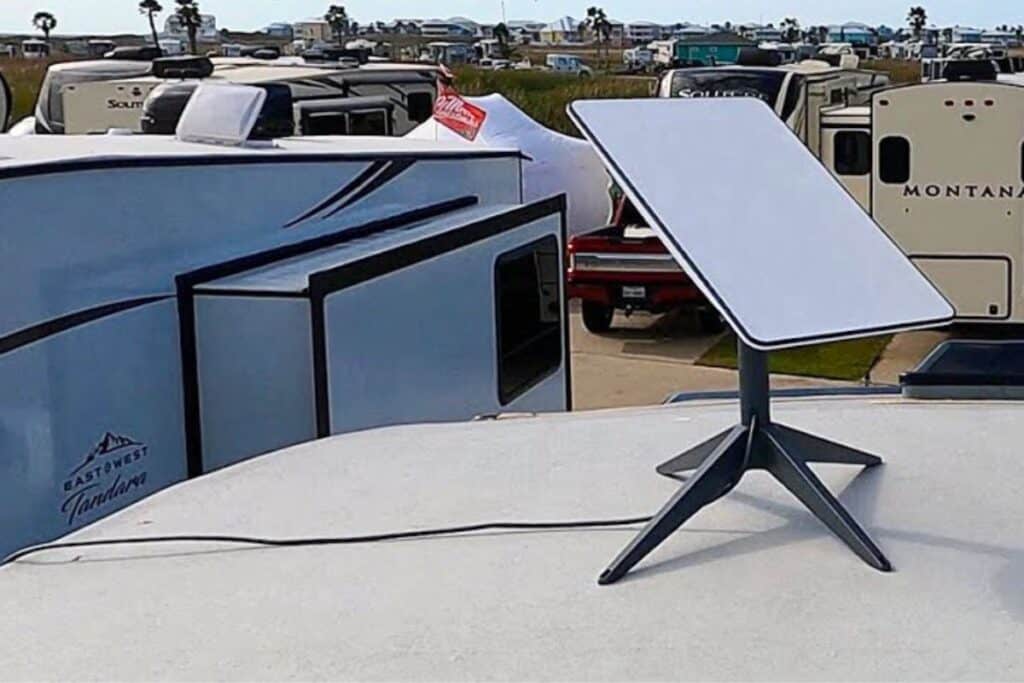
Reliable internet access is the lifeline of full-time RV living, especially when working remotely. Below are some of the best and most popular reliable mobile internet access options.
Best Mobile Internet Solutions:
- Cellular data plans from multiple carriers (Verizon, AT&T, T-Mobile)
- Satellite internet (Starlink) for remote areas
- WiFi extender for campground connections
Setting up your RV’s internet is generally more complicated than home internet and often requires a multi-prong approach.
A quality cell phone booster serves as your first line of defense against weak signals, while a roof-mounted omnidirectional antenna helps capture signals from multiple directions. Installing a reliable router creates a stable network throughout your RV, and a signal meter is invaluable for finding the optimal parking spot for reception.
For the ultimate in RV internet, there is no better option than Starlink, as it allows you to get high-speed internet no matter where you are.
Before investing in any internet setup, take the time to research coverage maps from different carriers to understand their network strengths in your planned travel areas. It’s also important to budget for both equipment ($500-1,500 initial setup) and monthly service ($100-300).
Mobile Internet Tips:
- Don’t rely on campground WiFi as your primary connection
- Maintain at least two different internet connections for redundancy
- Use websites like CoverageMap.com or Campendium to find good signal areas
7. Have a Plan to Stay Healthy from the Road
Maintaining your health while traveling requires thoughtful planning and consistent routines. Don’t make the mistake of neglecting your health due to your nomadic lifestyle.
Healthcare Essentials:
- Establish a home base for insurance purposes
- Find medical providers that offer telehealth services
- Keep digital copies of all medical records
- Build a network of providers along your route for routine check-ups and screenings.
- Choose a pharmacy with nationwide stores to fill your prescriptions
Staying Active:
- Create a portable exercise routine
- Pack compact fitness equipment
- Use hiking trails and campground facilities
- Join a national gym chain for access across the country
- Download fitness apps or use YouTube for guided workouts
Healthy Mobile Living Tips:
- Stock your RV with nutritious, non-perishable foods
- Invest in quality food storage containers
- Use farmer’s markets for fresh produce
- Maintain regular sleep schedules
- Practice stress management techniques
Emergency Preparedness:
- Keep a well-stocked first-aid kit
- Maintain emergency contact information
- Consider medical evacuation insurance
- Store important medical documents digitally
Remember, prevention is key. Regular exercise, healthy eating, and stress management are easier to maintain than trying to recover from illness on the road. Make your health a priority by establishing these routines before you begin your full-time RV journey.
8. Understand & Know Where You Plan to Stay
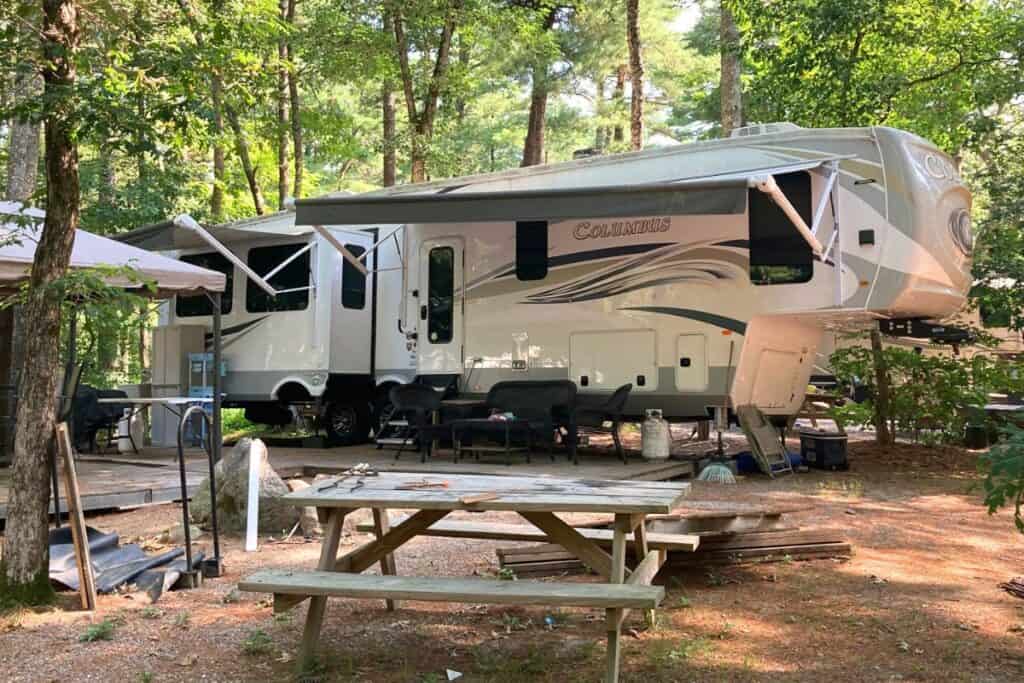
Planning where to park your home on wheels is a crucial aspect of full-time RV living and requires both structured reservations and flexibility for spontaneous adventures.
Places to Stay While Full-Time RVing:
- Private RV parks offer full hookups and amenities but come at a higher cost, typically ranging from $30 to $100+ per night.
- State and national parks provide stunning locations and reasonable rates but often have length restrictions and limited hookups.
- Boondocking on public lands offers free camping with no amenities, perfect for self-sufficient RVers with solar power and large water tanks.
You can also join camping membership programs to reduce costs. Networks like Thousand Trails, Harvest Hosts, and KOA can significantly lower your camping expenses. Many full-timers combine these memberships with occasional boondocking to keep their monthly camping budget manageable.
For popular destinations, especially during peak seasons, make reservations several months in advance. National parks and beachfront campgrounds often book up 6 to 12 months ahead.
9. Have a Plan for Mail & Packages
Managing mail and packages while living on the road requires a reliable system that works with your travel lifestyle.
The best and most efficient option for most full-time RVers is a professional mail forwarding service.
Mail forwarding services provide a permanent physical address, which is essential for driver’s licenses, vehicle registration, insurance, and banking. These services receive, scan, and forward your mail to you. Top providers like Escapees RV Club, Good Sam, or St. Brendan’s Isle offer various service levels, from basic mail forwarding to virtual mailbox solutions where you can view and manage your mail online.
Most mail forwarding services cost between $100 and 200 annually, but the convenience and reliability make it a worthwhile investment for full-time RVers.
For packages, consider using Amazon Lockers or general delivery at local post offices. Many RVers also maintain relationships with family members or trusted friends who can receive occasional packages. Most campgrounds will also accept packages for current guests, but always check their policy before having items shipped, as some charge handling fees or have size restrictions.
It’s also a good idea to minimize the amount of physical mail you receive by:
- Switching to paperless billing for all accounts
- Setting up online banking and bill pay
- Canceling unnecessary subscriptions
- Switching to digital newspapers and magazines
10. Get Your Insurance & Documentation in Order
Getting your insurance and documentation organized before hitting the road is crucial for worry-free full-time RV living.
Start with RV insurance specifically designed for full-time living. Standard recreational policies won’t provide adequate coverage for full-timers, you’ll need coverage similar to a homeowner’s policy since your RV is your primary residence. Make sure your policy includes personal liability, personal property coverage, and emergency expense coverage. Most full-timers also add roadside assistance through companies like Good Sam or Coach-Net.
Essential documents to organize:
- Vehicle registration and insurance cards
- Health insurance cards and medical records
- Passport and driver’s licenses
- Warranty information
- Bank and credit card information
- Emergency contacts list
It’s also a good idea to keep digital copies of all important documents in secure cloud storage, with physical copies stored in a fireproof container.
11. Don’t Forget About Community & Support Systems
While full-time RV living offers incredible freedom, maintaining connections and building community is vital for long-term nomadic happiness.
Building your RV community starts before you hit the road. Join online RV groups and forums to connect with experienced full-timers. Facebook groups, RV-specific forums, and platforms like Instagram help you find like-minded travelers and gather valuable insights. Popular communities like Escapees RV Club or Xscapers offer both online and in-person connections, hosting meetups and rallies throughout the year.
It’s also important to stay connected with family and friends back home through regular video chats and social media updates. Consider setting up a blog or private Facebook group to share your adventures and maintain those important relationships.
Also, plan your route to include visits with family and friends when possible – these familiar connections help balance the transient nature of RV life.
Finding community on the road happens naturally when you:
- Attend RV rallies and meetups
- Join RV clubs and membership organizations
- Participate in hobby groups that travel
- Volunteer at destinations you visit
- Stay at social-oriented campgrounds
Remember, the RV community is incredibly welcoming and supportive. Don’t be shy about introducing yourself to neighbors or joining group activities at campgrounds. Some of your future closest friendships might be started with a simple conversation in a campground laundry room.
12. Plan Out & Book Your First Two Weeks on the Road
Your first two weeks of full-time RV living are crucial for building confidence and working out any issues.
Start by choosing a route that keeps you close to your local area. Plan your first destination within a 2 to 3-hour drive and book a full-service RV park with good reviews and a helpful staff. This will give you a comfortable safety net.
Also, avoid long driving days initially, you’ll be surprised how tiring it can be.
For your first two weeks, I recommend this timeline:
- Days 1-5: Stay at a nearby full-hookup campground to get comfortable with your RV and RV lifestyle
- Days 6-10: Move to a second campground within easy driving distance
- Days 11-14: Try a state park or less developed campground once you’re comfortable
Also, make reservations well in advance and have backup options ready. Keep your schedule flexible enough to stay longer at each stop if needed.
It’s also important to create a detailed checklist for setup and departure, so you don’t miss or forget anything.
Most importantly, be patient with yourself during this initial learning period. Every full-time RVer starts as a beginner, and these first two weeks are about learning, not perfection.
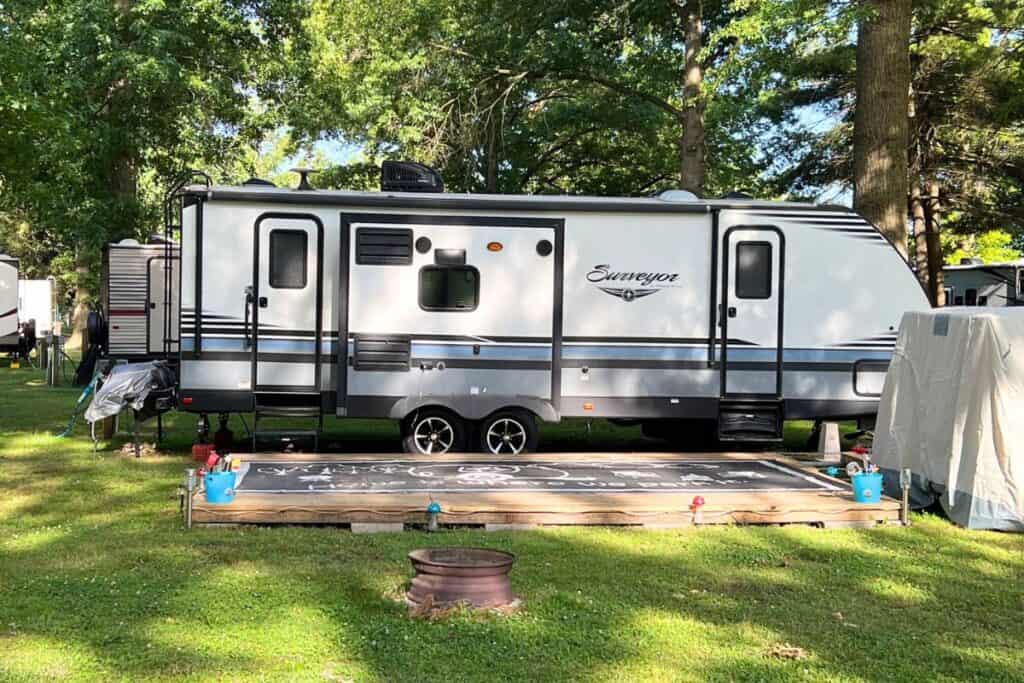
Additional Full-Time RV Living Resources:
- Best RV Parks for Full-Time Living: By State
- 8 Best Class B+ RVs for Full-Time Living: Rolling Homes
- The 10 Best Small Travel Trailers for Full-Time Living
Recent Posts
When cruising down the highway in your RV, the last thing you want is a tire blowout! Not only is it dangerous, but RV tire replacement isn't cheap, costing $200 to $300 per tire. The good news,...
Nothing ruins an RV adventure faster than a breakdown with no way to fix it. Because of this, every RVer should have a well-stocked RV tool kit for those unexpected roadside emergencies and campsite...
